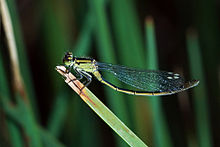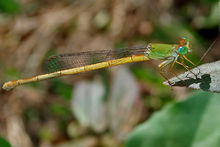mk
имиња во трошки


The insect family Coenagrionidae is placed in the order Odonata and the suborder Zygoptera.[2] The Zygoptera are the damselflies, which although less known than the dragonflies, are no less common. More than 1,300 species are in this family, making it the largest damselfly family. The family Coenagrionidae has six subfamilies: Agriocnemidinae, Argiinae, Coenagrioninae, Ischnurinae, Leptobasinae, and Pseudagrioninae.[3]
This family is referred to as the narrow-winged damselflies or the pond damselflies.[4] The Coenagrionidae enjoy a worldwide distribution, and are among the most common of damselfly families. This family has the smallest of damselfly species. More than 110 genera of the family Coenagrionidae are currently accepted.[5][3]
The name may be derived from Greek coen meaning shared or common and agrio meaning fields or wild.

Adults are seen around various habitats including ponds and wetlands. The females lay their eggs among living or dead submerged vegetation, and in some species, even crawl about underwater depositing their eggs. The nymphs are usually found in debris or among living or dead submerged plant material.[6]





These genera belong to the family Coenagrionidae:[7][8][3]
The insect family Coenagrionidae is placed in the order Odonata and the suborder Zygoptera. The Zygoptera are the damselflies, which although less known than the dragonflies, are no less common. More than 1,300 species are in this family, making it the largest damselfly family. The family Coenagrionidae has six subfamilies: Agriocnemidinae, Argiinae, Coenagrioninae, Ischnurinae, Leptobasinae, and Pseudagrioninae.
This family is referred to as the narrow-winged damselflies or the pond damselflies. The Coenagrionidae enjoy a worldwide distribution, and are among the most common of damselfly families. This family has the smallest of damselfly species. More than 110 genera of the family Coenagrionidae are currently accepted.